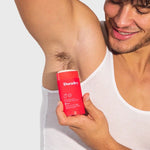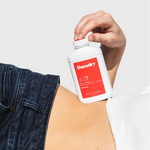If you suffer from excessive groin sweating, you may want to to learn the causes, types of treatments, and how to avoid this embarrassing sweat. You may want to discuss your problem with your dermatologist or primary-care physician who may be help you with proper treatment.
Lets talk from the begining...
There are two types of sweat glands: eccrine and apocrine. Both types are found in the armpits and groin. Eccrine glands are more numerous than apocrine glands and are associated with hair follicles in the axillary region.
Excessive sweating in the groin area is caused by the apocrine glands, which produce fluids that contain protein. When the fluids come into contact with bacteria, they can create an unpleasant smell. Sweat from this area can also cause itching and can lead to infections.
The amount of sweat secreted depends on the number of functional sweat glands and the surface area of these glands. The glands' secretory activity is controlled by hormonal and neural mechanisms.
Excessive sweating or hyperhidrosis occurs when the sweat glands and nerves in the body are overactive. In people who sweat excessively, they become susceptible to skin infections and social embarrassment. The condition is often a sign of another underlying disease.
Over-the-counter products like antiperspirants can help control the sweating in the groin area. These products differ from deodorants in that they contain an active ingredient that reduces sweat production.
Keeping your groin dry
If you have a tendency to sweat in your groin, a few lifestyle changes can help.
First, avoid wearing synthetic fabrics, which tend to trap moisture and odor. Instead, wear natural fabrics that breathe. These fabrics will also keep your body temperature more balanced.
Skin-tight clothing, such as panties or shorts, will increase the risk of excessive sweating in your groin. Not only will they make you sweat, but they will also create an odor that can make you feel uncomfortable.
Although sweating in your groin is usually not a life-threatening problem, excessive sweating can be embarrassing and offensive. There are several treatments that can help you control the problem, from simple and inexpensive home remedies to medical interventions.
One way to reduce groin sweat is to use an absorbent powder. These can be made from talc, baby powder, or a starch-based powder, such as corn starch. Alternatively, you can use prescription-strength antiperspirants. Regardless, of which type of antiperspirant you choose, never put it inside your vagina. While these products may be effective, they can also cause damage to the vaginal lining.

Using antiperspirants
Over-the-counter antiperspirants and deodorants are often used as a first line of treatment for excessive sweating and are available to treat sweating in the groin area. These products contain a substance called aluminum chloride, which works by blocking the sweat glands.
The International Hyperhidrosis Society recommends metallic ingredients in antiperspirants, which work by sealing the sweat ducts. However, these chemicals can cause irritation to some people, so you should always test the product on a small patch of skin to avoid any possible side effects.
Surgical removal of sweat glands
Surgery is an option for people with severe hyperhidrosis. The procedure, called ETS, involves removing the sweat glands and the nerves that control them. It is a major operation that carries risks. While it can significantly reduce excessive sweating, it can also cause other problems, such as compensatory sweating.
While ETS has many benefits, it has also been a controversial procedure. Some doctors do not recommend it because it can be risky. Even though some patients have reported good results, others have developed compensatory hyperhidrosis, where they sweat excessively to compensate for the reduced number of sweat glands.
Excessive sweating in the groin area is a common medical condition, known as hyperhidrosis. While it is normal to sweat during hot weather, excessive sweating in the groin area can be embarrassing and irritable. It is essential for the body to keep cool, but over-sweating is a significant problem. This condition is caused by overactive sweat glands, and those who suffer from it can experience significant physical and psychological discomfort. The signs and symptoms usually first appear during adolescence or early adulthood.


